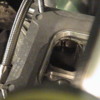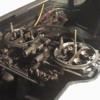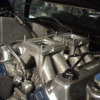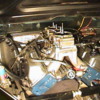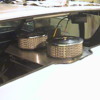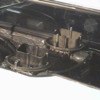...My Friends, I Thank You for Your interest! This 'project' was purely experimental at the beginning, as the Weiand Tunnel-Ram (I think the Most Beautiful Manifold ever created for the Cleveland) was Highly Modified. Being too tall and radical; the entire Top portion adaptor (3.0" in Height) was removed and 'discarded' (sold on eBay). Adaptor plates were machined to mount Twin Holleys. The plates total 1.0", in effect lowering the Entire Assembly 2". It was by accident that the aircleaner mounting 'plane' came up Exactly in-line to the decklid surface. I never cared for the engine covers. I never had the center cover, and who would want to cover over that beautiful Ford Cleveland, anyway. The results were beyond even My expectations; in a word 'Smooth' delivery of power from off idle to Infinity! Or until Valve float, or She 'Blows'! Without even trying, your breaking the tires loose from at a stoplight. Gently driving around corners will still 'Break them loose'! It's quit a feeling. (Try explaining 'That' to the Police, when pulled over!) Fuel Distribution at Any RPM was never an issue. The linkage is NOT progressive. All primaries open at an equal rate. I chose to use Vacuum Secondaries, as Mech. Secs. are for 'Race Only'; because the Transition and Cruise curcuits are activated constantly, wasting fuel. In the pictures the carbs with the choke horns milled off are 600 cfm, they gave me an honest 10-12 MPG. The carbs with choke horns (seen in my avitar) are the 450's and have not yet been tested. But I know they will give a higher MPG. Also the 450's (according to the 'Desktop Dyno') give slightly more Horsepower And Torque from 2000-5000 RPM. Equal to the 600's from 5000-7000; with the 600's pulling ahead only after 7000 RPM, which I don't expect to ever push this engine to! Would I do it again!? Thats a Big YES!! Because I can always go back to the 'Torker' and single 750. But! The neccessary decision to 'slightly' cut the deck-lid; I agonised over for just about a Year, before making my mind up to Go For It! It's My Pantera and This is the way I want it. I won't be 'here' when the Next owner takes the Keys, so be it. I do NOT claim that the Desktop Dyno Program will ever take the place of a 'Real' Dynomometer; but it is a Great place to start, experiment with different parts, and remove some of the guesswork out of the equations. Here are the figures I came up with. Enjoy the pictures! If You need to see more, we can work something out. I have Hundreds of them! The power bands are high in the Revs! This engine is not a stroker, it's just a .030 over 351. All figures are 'At The Flywheel'. With the twin 600's CFM: 500 HP @ 6000 RPM, Max. 525 HP @ 7500 RPM, 447 LB/FT @ 5500 RPM. With twin 450's: 495 HP @ 6000, Max. 515 HP @ 7000, 446 LB/FT @ 5000 RPM. If we go to twin 390's: 490 HP @ 6000, Max. 508 HP @ 7000, 446 LB/FT @ 5000 RPM. With the little 390's I would expect to get somewhere around 18 MPG. Remember, Yes! There are two 4 barrels, But! Each Carburator is only effected by Half of the Engines Total Vacuum. And it's the Vacuum that defines how much fuel is used. The Priority of all this experimentation was to put One Venturi over Each Intake Port and maintain a 'resonable' Fuel/Air Planum! I may have to post the Pics in a following post. Stay tuned! "...Long May You Run...", and God Bless America!!...


